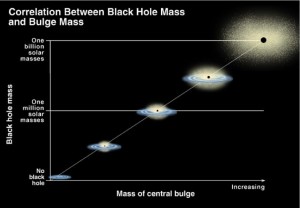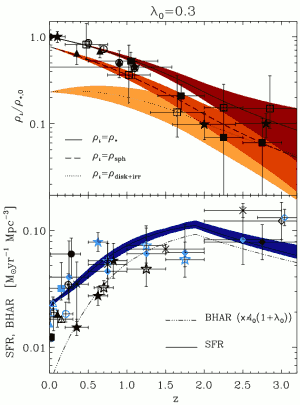 |
|
Fig. 1: A schematic representation of the correlation between black
hole masses and host spheroids, observed in the local Universe.
Credit: NASA and A. Feild (STScI)
|
 |
 |
|
Fig. 2:
The top panel shows the evolution in the stellar mass density, solid
line with dark-red shaded area) as a function of redshift, z (where
z=0 corresponds to today and z=3 to approximately 10 billion years
ago). The density is given as a ratio to today's value. The predicted
stellar mass density has been calculated from the evolution of the
black hole mass density.
Also shown are the relative decomposition of
the total stellar mass density into spheroids (dashed line, orange
shaded area) and disks and irregulars
(dotted line, light-orange shaded area). This shows that the stellar
mass in galaxies was almost equally divided between bulges and
disks/irregulars in the past, but is dominated by the bulges today.
The lower panel shows the evolution in the star formation rate (solid
line and dark blue shaded area) and the corresponding black hole
accretion rate density (dot-dashed line) rescaled by a factor of about
one thousand. Since z=2, black holes grew more slowly than the stars,
as indicated by the dot-dashed line rapidly declining towards z=0.
The data points are a collection of all the available measurements of
the total stellar mass density (upper panel) and star formation rate
density (lower panel) in the Universe as a function of time.
|
|  |
Black holes, with masses from a few millions to a billion times
that of the sun reside in the centers of nearby galaxies.
Even more remarkably,
recent observational evidence indicates that the mass of the central
black hole is tightly correlated with the total
mass (and luminosity) of the
stars in the central, spheroidal component of galaxies, called bulge.
The larger the black hole, the larger the bulge (see Fig.1). These
discoveries imply that the formation of the galactic spheroids (and of
galaxies themselves) must be intimately connected to the growth of the
central black hole, as recent numerical simulations performed at the
Max Planck Institut für Astrophysik
have indeed been able to show (see  Colliding galaxies light up dormant
black holes). Colliding galaxies light up dormant
black holes).
In the local Universe, black holes not only comprise a fixed fraction
(about 1 part in a thousand) of the mass of their host galaxies, as
indicated by the black hole--bulge correlations, but they are also known
to be growing at a rate proportional (still a factor of about
one part in a thousand) to the rate at which stars are being formed
(see  Low Mass Black Holes Still Grow Today). But was this true
also in the past? Low Mass Black Holes Still Grow Today). But was this true
also in the past?
From observations of Active Galactic Nuclei (AGN) and Quasars (QSOs),
the most powerful class of AGN, we know that black holes must
have assembled at the time when galaxies were still forming.
According to the
standard picture, AGN are powered by the release of
gravitational energy from matter that falls onto a supermassive black
hole. Therefore, measuring the amount of radiation emitted by the
active galactic nuclei gives a measure of how fast the black holes grow.
Andrea Merloni, Gregory Rudnick and Tiziana Di Matteo at the
Max Planck Institut für Astrophysik have
collected the most up to date information on the evolution over cosmic
time of the AGN population, and derived from that the history of black
holes mass assembly in galaxies. Then, they have compared it with all
available measurements of the total stellar mass residing in
galaxies and of the rate at which it was assembled since early times
(about 10 billion years ago) till today.
Figure 2 illustrates the results they have obtained in details. The upper
panel shows the data of the evolution in the observed stellar
mass density in the Universe (total mass in stars per unit volume)
as a function of time, together with the best approximation
calculated from the known evolution of
the black hole mass density. The prediction shown by the solid curve
implies a non-constant
ratio between black hole mass and host spheroid mass.
The lower panel shows the evolution in the star formation rate
and the corresponding black hole
growth rate (rescaled by a factor of about one
thousand).
This study demonstrates, for the first time, that
the correlation between black hole mass and galactic bulge properties
observed in the local Universe has evolved and was different in the
past. Black holes and bulges do indeed grow together, but not at the
same rate. The researchers have found that supermassive black holes
assembled earlier than bulges: 10 billion years ago they were about 1.7
times larger than their host spheroids compared to today.
Since then, black holes have grown less compared to the rate at
which their hosts have.
These results, combined with future sensitive observations of even
more distant galaxies and Quasars, will help scientists
to better understand how the first stars and black holes assembled in
the early Universe.
Andrea Merloni
Further Information:
A. Merloni, G. Rudnick & T. Di Matteo: Tracing the cosmological
assembly of stars and supermassive black holes in galaxies, MNRAS, 356, L1, 2004
|



